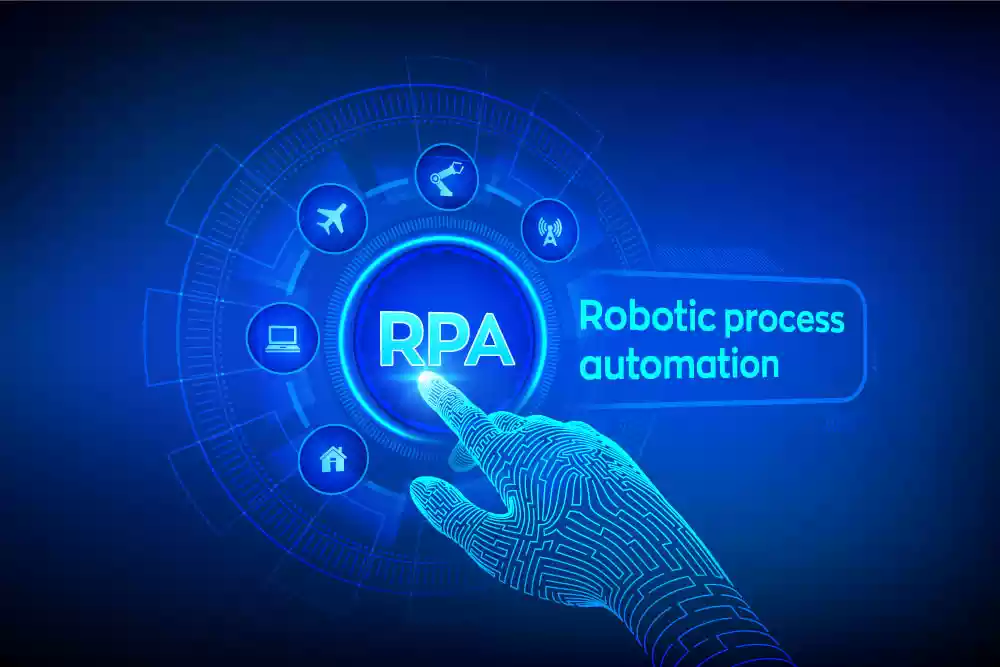The healthcare industry of today is overburdened by high costs, incredibly high volume and stringent regulations. These pressures can challenge the quality and urgency of patient care.
What is robotic process automation (RPA)?
Robotic process automation (RPA) is an automation technology that uses software to mimic the back-office tasks of human workers, such as extracting data, filling in forms and moving files. It combines APIs and user interface (UI) interactions to integrate and perform repetitive tasks between enterprise and productivity applications. By deploying scripts that emulate human processes, RPA tools complete autonomous execution of various tasks, activities and transactions across unrelated software systems.
The value of RPA
Healthcare organizations operate in real-time, without any slack. Cumbersome, error-prone tasks slow down processes and affect everything from cost structures to compliance to the patient experience. RPA software creates efficiencies by automating tasks that improve the accuracy of data and reporting and enable decisions to be made more quickly. This translates to cost savings and ultimately means that resources can be utilized where they are needed most.
RPA automates tasks that use structured data and logic, and it often relies on a business rules engine to automate decisions based on predefined rules and conditions. It is possible for RPA to manage unstructured data sets as well, but only if a bot first extracts the data and then uses capabilities like natural language processing (NLP) and optical character recognition (OCR) to create structured data.
An RPA solution, when used in conjunction with artificial intelligence (AI), creates intelligent automation (IA) (or cognitive automation), which aims to closely mimic human talent and actions, often through the use of bots.
What use cases in healthcare can be improved with RPA, and how?
The healthcare industry involves many highly sensitive interactions with customers, but it also includes many time-consuming, repetitive tasks and administrative tasks that don’t require specialized knowledge. RPA can provide task automation across the organization, from front-office tasks to operational processes to patient interaction and bill payment.
According to Gartner, “50% of US healthcare providers will invest in RPA in the next three years.” Gartner continues, “Healthcare providers are caught in a perfect storm of shrinking payments, improving outcomes, enhancing experience and bolstering credentials. Any technology implemented to help these providers improve delivery and streamline operations must also optimize costs.”
Some of the challenges in healthcare that can be mitigated with RPA include the following:
- Administrative data entry: Administrative data is just one of many types of data encountered in a healthcare setting. Administrative data entry often doesn’t require specialized skills, but it’s a task that can be very repetitive. Using natural language processing (NLP), speech recognition and image recognition, RPA can be used to take data inputs from various sources, some of which may need to be converted to structured data using bots. That data must then be input into a database or other repository for use by the organization.
- The document digitization process: RPA can use intelligent document processing (IDP) to prepare and ingest documents — related to anything from health records to insurance claims — into a larger repository for storage or use.
- Manage and schedule patient appointments: Appointment scheduling and management can benefit from automation using RPA bots and other processes to interact with customers. It’s also possible to schedule, change, cancel or update patent appointments as needed or requested.
- Billing and processing: Billing and claims processing are typically very repetitive. These processes can be automated using RPA, with bots handling claims management, including first-line inquiries or follow-up.
- Records management: The healthcare industry is highly regulated, requiring very stringent protocols and reporting with respect to patient records, medical records and other sensitive information. Regulatory compliance is dependent upon accuracy, consistency and protection of records, which RPA can provide.
- Infection control: RPA can be used to help healthcare professionals execute infection control protocol, including but not limited to:
- Managing triage tasks
- Tracking protocols and screening, including regulatory compliance and CDC protocols
- Managing inventory and patient flow
- Monitoring patient care plans and alerting staff based on patient data thresholds
- Communications: In healthcare, as in any industry, RPA can be used to automate communications like responses to inquiries on the website, first-line calls to customer service, front-line administrator queries and email blasts to patients, vendors and staff
- Customer service and remote care: RPA and bots can be used to automate repetitive customer service and remote care activity, with machine learning and intelligent automation (IA) providing the ability to address repetitive questions with consistency and expediency. RPA can also be used in follow-up for remote care, following business rules to deliver specific communication at certain steps in the patient care plan.
Benefits of RPA in healthcare
With pressire to reduce costs, increase the speed of operations, simplify tasks, increase the efficiency of business processes and improve the patient experience, healthcare organizations are positioned to benefit greatly from RPA.
Healthcare leaders can implement RPA to do the following:
- Reduce healthcare administration costs by automating repetitive manual tasks that are time- and resource-intensive.
- Increase the speed of processes, such as triage, through the automation of mundane tasks.
- Improve the accuracy of data, tasks and reporting in clinical settings and others by reducing human error, ensuring task and output consistency and enabling organizations to successfully put best practices in place.
- Improve productivity of healthcare staff by automating tasks that don’t require human intelligence or thought, freeing up resources to focus on more complex activities.
- Improve the patient experience with more consistent care because of more accurate decisions, reduced costs and greater visibility across the entire patient record.






